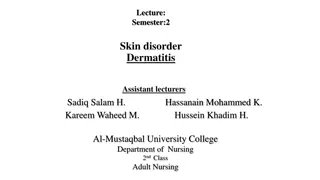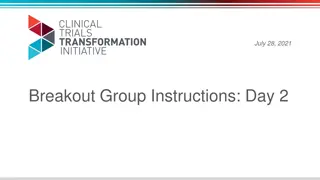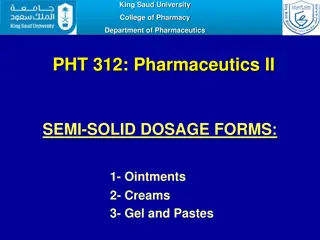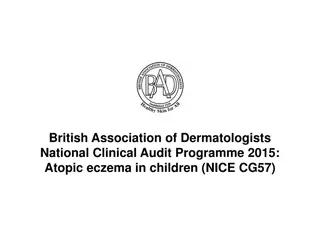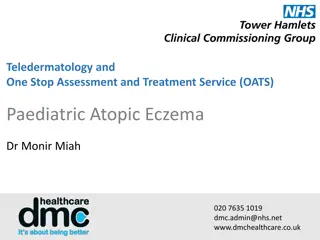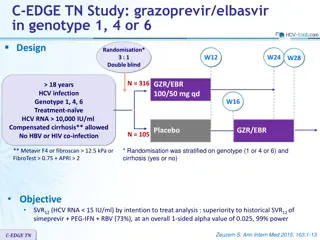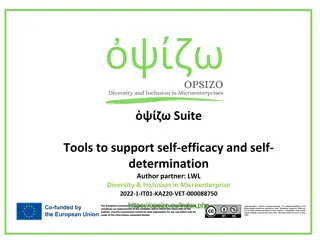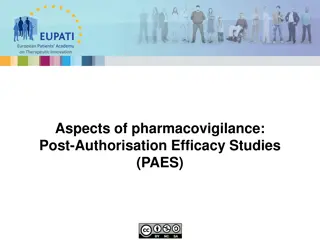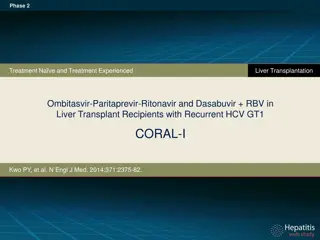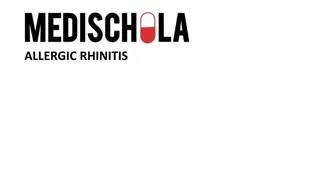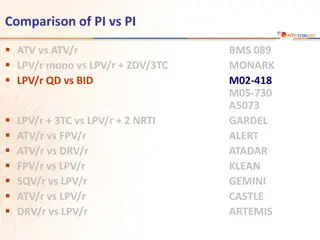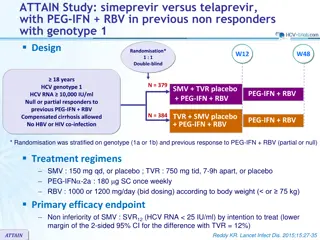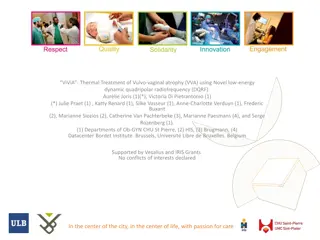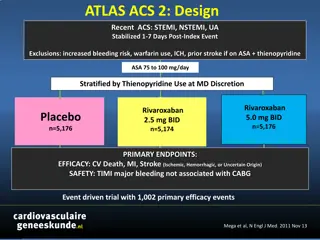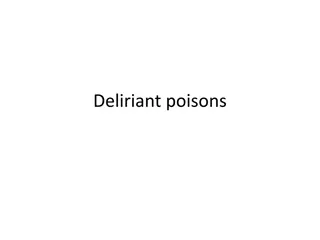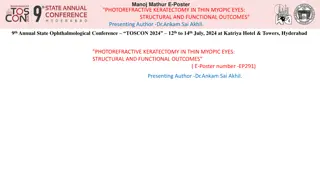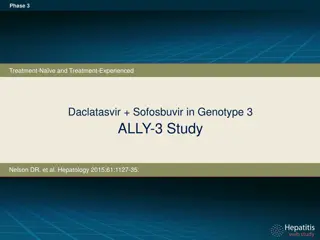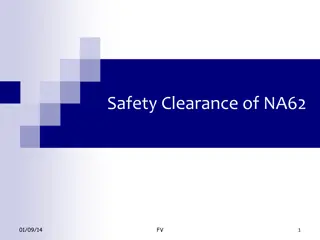Efficacy and Safety of Crisaborole Ointment in Atopic Dermatitis Treatment
This study highlights the effectiveness and safety of crisaborole ointment, a nonsteroidal phosphodiesterase 4 inhibitor, in treating atopic dermatitis in children and adults. The medication showed significant improvement in patients with mild-to-moderate atopic dermatitis, with minimal side effects such as application site burning or stinging. Crisaborole offers a new class of topical treatment without the limitations of corticosteroids or calcineurin inhibitors, providing potential benefits for patients seeking minimal rash, itch, and disease complications.
Download Presentation

Please find below an Image/Link to download the presentation.
The content on the website is provided AS IS for your information and personal use only. It may not be sold, licensed, or shared on other websites without obtaining consent from the author. Download presentation by click this link. If you encounter any issues during the download, it is possible that the publisher has removed the file from their server.
E N D
Presentation Transcript
Efficacy and Safety of Crisaborole Ointment, a Novel, Nonsteroidal Phosphodiesterase 4 (PDE4) Inhibitor for the Topical Treatment of Atopic Dermatitis (AD) in Children and Adults Paller A, Wynnis T, Lebwohl M, et al. http://www.jaad.org/article/S0190-9622(16)30330-9/abstract
Faculty Reviewer Comments Highlights of the Study This study was instrumental in the approval of crisaborole by the US Food and Drug Administration for topical treatment of mild-to-moderate atopic dermatitis in patients age 2 years At study entry 86% of the patients were age 2-17 years Two-thirds had moderate atopic dermatitis There was a high vehicle response rate, likely because of its hydrating effect Crisaborole is the first topical phosphodiesterase-4 inhibitor for atopic dermatitis No evidence of systemic adverse events observed with oral phosphodiesterase-4 inhibitor therapy (apremilast)
Faculty Reviewer Comments Implications for Clinical Practice New class of topical treatment that avoids limitations with topical corticosteroids and topical calcineurin inhibitors Availability of this new medication should reinforce the treatment goal of minimal rash and itch, as well as minimal disease complications such as sleep disturbance
Principal Investigator Comments Highlights of the Study Crisaborole ointment is the first topical inhibitor of phosphodiesterase-4, an enzyme known to be activated in atopic dermatitis, leading to inflammation In both phase 3, 28-day, double-blind, randomized, controlled studies in children as young as 2 years of age and adults with atopic dermatitis, a significantly greater number achieved clear or almost clear status with at least a 2-grade improvement using crisaborole ointment vs vehicle The only treatment-related side effect that occurred in at least 1% of the more than 500 patients given crisaborole ointment in the study was application site burning or stinging, which was reported by 4.4%
Principal Investigator Comments Impact on Patient Care Many patients, families, and physicians remain concerned about using topical steroids for treating atopic dermatitis. Even for physicians who use topical steroids as the mainstay of treatment, their chronic use to maintain control and application to sensitive areas, such as the face, can be worrisome. The only available alternatives have been the calcineurin inhibitors, which have an associated black box warning, necessitating explanation about the theoretical risk of cancer (which has not materialized) to offset the required mention by the pharmacist with dispensing. Phosphodiesterase-4 inhibitors, including crisaborole, are a welcome nonsteroidal addition, especially for use with milder disease, for sensitive skin areas, and to reduce the chronic need for steroids.
Two Phase 3 Trials of Dupilumab Versus Placebo in Atopic Dermatitis Simpson E, Bieber T, Guttman-Yassky E, et al. http://www.nejm.org/doi/pdf/10.1056/NEJMoa1610020
Faculty Reviewer Comments Highlights of the Study Dupilumab represents the first prospectively developed, selective immunologic agent that targets atopic dermatitis The mechanism of action of dupilumab and its efficacy in atopic dermatitis as reported in this study emphasize the role of T-helper type 2 (Th2) cytokines in the pathogenesis of atopic dermatitis There was remarkable improvement in objective scores of skin clearing, as well as patient-reported outcomes, such as depression and anxiety
Faculty Reviewer Comments Implications for Clinical Practice The availability of dupilumab should impact state-of-the-art management of adults with moderate-to-severe atopic dermatitis Other systemic medications are not often used because of toxicity concerns and/or because they are not approved for atopic dermatitis in the United States Unanswered questions Which patients are appropriate candidates for dupilumab? It is not clear the requirements of insurance companies for coverage How long should dupilumab be continued? Will there be a relapse when stopped? Will some patients experience sustained remission? Role in children Significance and management of conjunctivitis
Principal Investigator Comments Highlights of the Study Dupilumab is a novel biologic that blocks both IL-4 and IL-13 whose use over 16 weeks in patients with atopic dermatitis had dramatic effects on skin inflammation, symptoms of itch, and quality of life Dupilumab did not function as an immunosuppressant as no increase in infectious outcomes were seen Symptoms of anxiety and depression were reduced as well
Principal Investigator Comments Impact on Patient Care At long last, dupilumab offers the potential to treat adult patients with moderate-to-severe atopic dermatitis with a targeted therapy that yields better efficacy without the toxicities encountered with currently available systemic therapies.
Efficacy of Sodium Hypochlorite (Bleach) Baths to Reduce Staphylococcus aureus Colonization in Childhood Onset Moderate-to-Severe Eczema: A Randomized, Placebo-Controlled Cross-Over Trial Hon KL, Tsang YCK, Lee VEY, et al. http://www.tandfonline.com/doi/pdf/10.3109/09546634.2015.1067669
Faculty Reviewer Comments Highlights of the Study Bleach baths are a compound intervention consisting of Water soak that washes away cerumen crust from the skin Bleach that may exert disinfectant or anti-inflammatory effects Emollients that are typically used immediately after bleach bath Patients in the study used emollients, but the timing isn t clear in relation to bathing This study showed that bleach baths are clinically effective but offer no significant benefit over water bath alone
Faculty Reviewer Comments Implications for Clinical Practice Since the addition of bleach to bath water offers no clinical benefit, clinicians should consider recommending water baths without bleach followed by emollients and/or topical steroids Avoiding the use of bleach may avoid safety and tolerability issues such as stinging and burning on open erosions or around the eyes
Efficacy and Safety of Ustekinumab Treatment in Adults with Moderate-to-Severe Atopic Dermatitis Khattri S, Brunner PM, Garcet S, et al. http://onlinelibrary.wiley.com/doi/10.1111/exd.13112/full
Faculty Reviewer Comments Highlights of the Study Ustekinumab in combination with topical corticosteroids is not consistently effective in moderate-to-severe atopic dermatitis Although the clinical response with ustekinumab was numerically better than placebo, the difference was not statistically significant In his own experience, Dr. Silverberg has seen no improvement with ustekinumab in patients with moderate-to-severe atopic dermatitis There was a high clinical response rate in the placebo group, likely because all patients received concomitant treated with topical corticosteroids Consistent with experience in psoriasis, ustekinumab is well tolerated in patients with moderate-to-severe atopic dermatitis
Faculty Reviewer Comments Implications for Clinical Practice It is possible that there is a subset of patients with moderate-to- severe atopic dermatitis who might benefit from treatment with ustekinumab Currently, no way of predicting who these patients are Ustekinumab is not currently recommended as a treatment for moderate-to-severe atopic dermatitis
Topical Tofacitinib for Atopic Dermatitis: A Phase IIa Randomized Trial Bissonnette R, Papp KA, Poulin Y, et al. http://onlinelibrary.wiley.com/doi/10.1111/bjd.14871/epdf
Faculty Reviewer Comments Highlights of the Study This is the first study showing benefit with a topical Janus kinase inhibitor in atopic dermatitis There was significant, rapid improvement in pruritus Topical administration of a Janus kinase inhibitor bypasses some of the issues with systemic Janus kinase administration There are several Janus kinase pathways in humans Further investigation is needed to identify which of these pathways should be inhibited to yield the best efficacy and safety ratio for atopic dermatitis
Faculty Reviewer Comments Implications for Clinical Practice Further investigation of topical administration of tofacitinib has been discontinued by the manufacturer However, this study shows the potential role of Janus kinase inhibition in the treatment of atopic dermatitis
Efficacy of Omalizumab in Patients With Atopic Dermatitis: A Systematic Review and Meta-Analysis Wang HH, Li YC, Huang YC http://www.jacionline.org/article/S0091-6749(16)30615-7/pdf
Faculty Reviewer Comments Highlights of the Study There is limited evidence to support the use of omalizumab in atopic dermatitis of any severity This meta-analysis has shown that omalizumab confers no benefit in patients with moderate-to-severe atopic dermatitis Most case series and studies of omalizumab have suffered from major methodologic flaws and selection bias
Faculty Reviewer Comments Implications for Clinical Practice Omalizumab is not consistently effective for moderate-to-severe atopic dermatitis, although it is possible that a subset of patients may benefit Dr. Silverberg has found profound benefit with omalizumab in some patients with overlapping atopic dermatitis and urticaria Omalizumab effectively treats the underlying itch, thereby reducing one of the triggers of itch in patients with atopic dermatitis Omalizumab is not recommended for moderate-to-severe atopic dermatitis Studies are needed to determine if a subset of patients with atopic dermatitis might benefit


